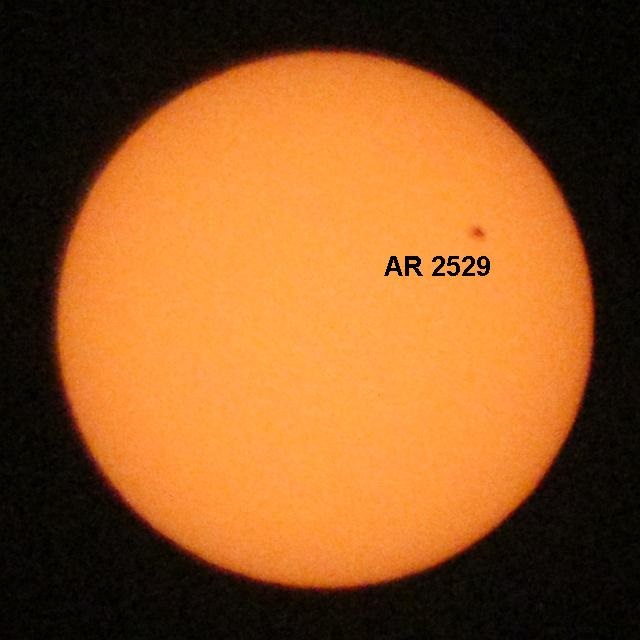According to several on line resources, we are probably headed toward the minimum end of the current eleven-year solar activity cycle. Giant sunspot AR 2529 looming toward the right limb of the sun may be the last large spot for a while as solar activity diminishes.
I took my Canon EOS Rebel SL1 out to the courtyard equipped with the 75-300 mm telephoto lens and an inexpensive solar filter to capture this image of AR 2529 before it fades as it circles out of view. Camera settings: 1/3200 sec., F5.6, ISO 6400, 300 mm focal length.


Yeah, this last cycle sure was a bust.
But, some of the usual “experts” were predicting (again!) that the currently waning cycle would be “Bigger than Cycle 19!!!!” like they always do.
Some of the solar “experts” in the ham community remind of the people who see Jesus on a piece of burnt toast!
After I got DXCC on CW, low bands didn’t interest me that much. I liked VHFing where propagation modes were what you made of them – sporadic E, meteor ion trails, EME and ducting were all there if you looked at the right time and place. Burnt toast and tea leaves were of no use – 😆
I was never in to “paper chasing”.
I’ve probably got 100 countries, but I prefer the technical aspect of the hobby, hence my interest in satellites.
I only got my certificates because I was active in the ARRL leadership for a while. Once that stint was over, it was all about the technical aspects of the chase for propagation and satellites and having fun with stuff like working Hawaii on 2 meters mobile from Palos Verdes and then all of a sudden the sporadic E kicked in and I was working British Columbia and Washington state on 144 SSB from the mobile with a sqloop antenna- good memories, no paper required. I still have the logs.
I always missed out on the big tropo duct to Hawaii. I was living in Torrance, and PV was directly in my path!
And as much time as I spent on 2M SSB, I never managed to be around for any of the openings that happened there, either.
The only interesting thing I did was to have a 2M packet station set up to beacon during several of the big meteor showers.
50 Watts and a 4-element beam pointed towards the “radiant” of the showers.
I managed to be heard and recorded by numerous stations several states away, so that was kind of cool.
I saw something that said if there was air to transmit sound from the sun to the earth, the sun would be louder (125 dB) at 93,000,000 miles than a train horn (120dB) at one meter away.
@drjim – There must have been some persistent ion trails for a complete packet to get through. That was cool.
@crotalus – I read a SciFi short story many years ago about future weather control of sunspots by occupants of vessels that could float on the solar surface unconsumed. One of the passages had one boat pilot opening a shutter on the boat’s exterior to hear the solar roar:
Meteor scatter is a common mode used to manage remote equipment.
It’s not very “broadband”, so you have to use a VERY low data rate, but it’s always there.
I almost didn’t believe it until I read some papers about companies using it for SCADA at remote sites.
https://en.wikipedia.org/wiki/Meteor_burst_communications